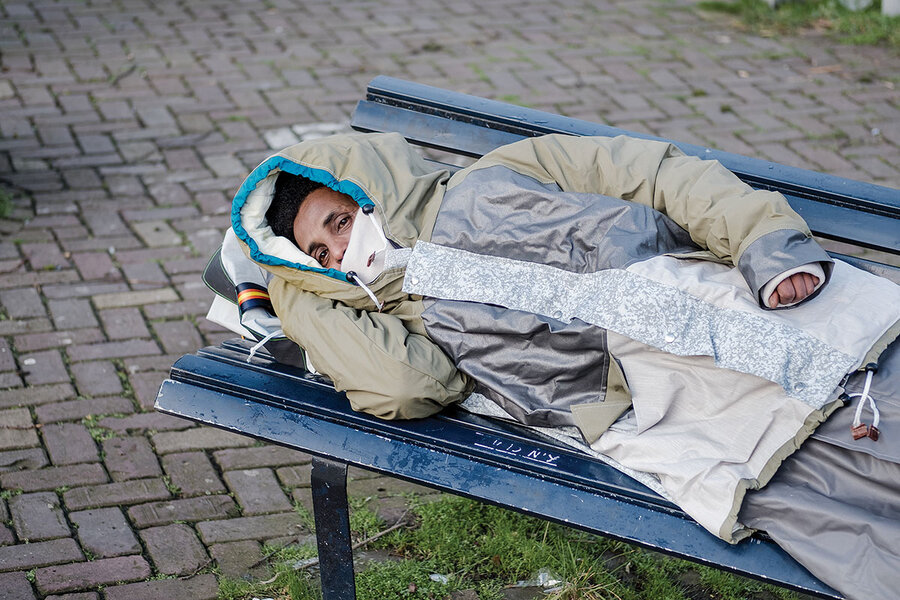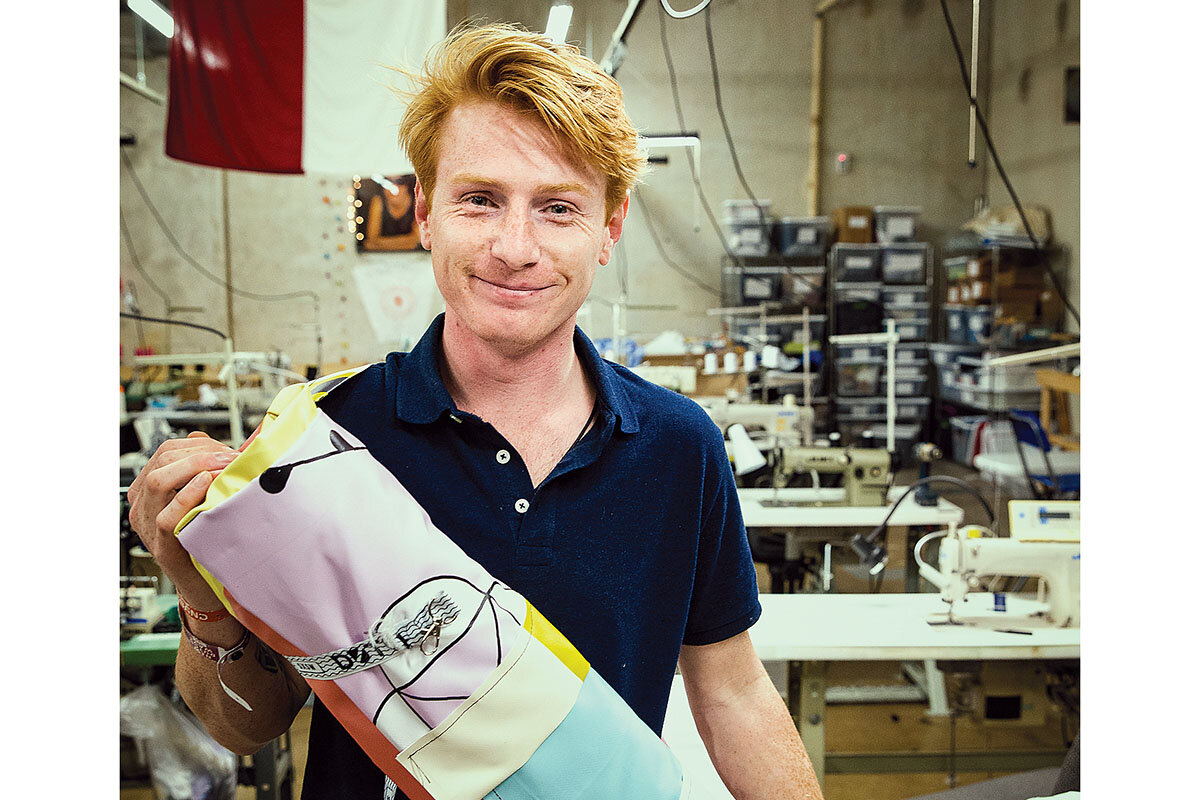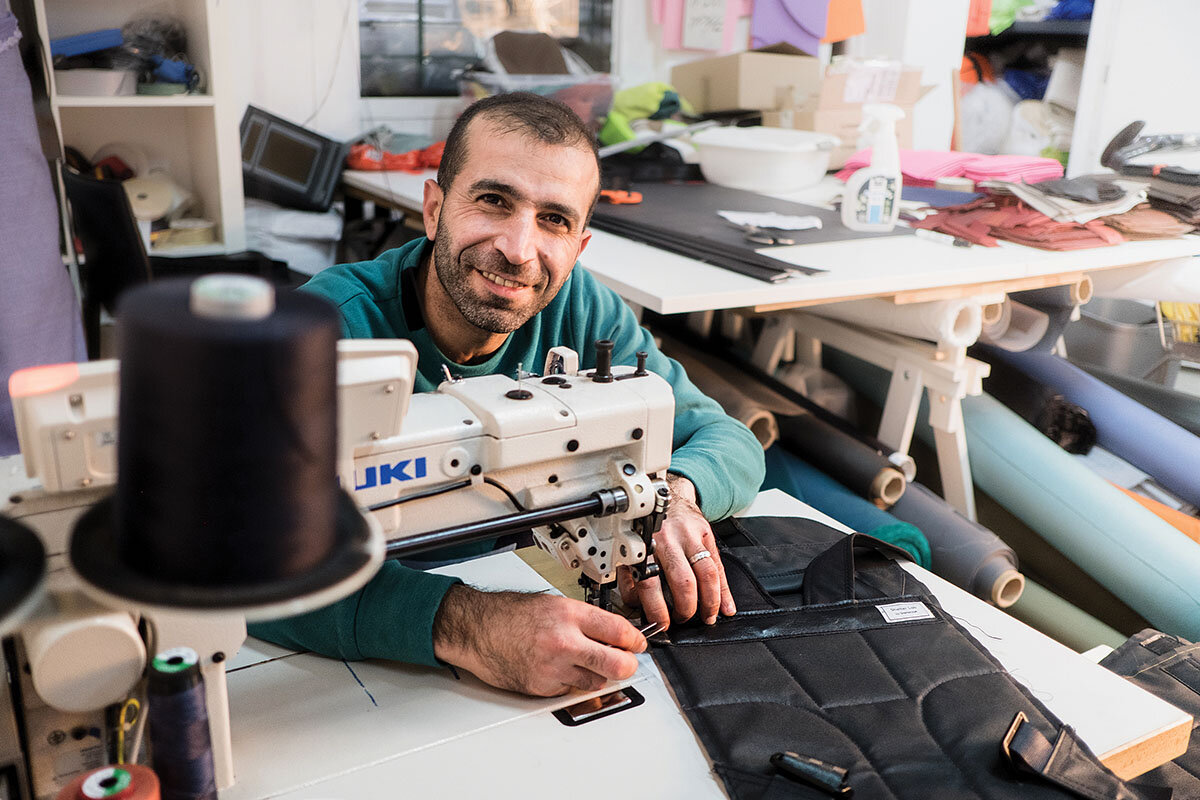Coat as shelter: Designer Bas Timmer creates for people who have no home
Loading...
| Amsterdam
Dutch clothing designer Bas Timmer has seen some tears in his line of work. But they have mostly been tears of joy.
During a visit to Cape Town, South Africa, Mr. Timmer met a woman who had lived her adult life on the streets, and was often cold and uncomfortable. Despite her disabilities, she managed to get by. While there was little he could do to change her circumstances, he could offer her a bit of warmth. So he gifted her one of his creations – a windproof and waterproof jacket that he had designed, called the Sheltersuit – and taught her how to use it.
When he checked on her a few days later, Mr. Timmer says she broke down, crying. She “was finally warm and cozy,” he says.
Why We Wrote This
Sometimes a vocation becomes a mission after an experience changes one's perspective. This Dutch designer wants to protect the homeless people of the world with his wearable jacket and sleeping bag.
With over 12,000 such suits distributed by Mr. Timmer’s Sheltersuit Foundation since 2014, he has had several such interactions, though none quite as emotional as his encounter in Cape Town. The suits have been handed out to people experiencing homelessness in the Netherlands; Lesbos, Greece; Sarajevo, Bosnia-Herzegovina; Edinburgh, Scotland; and London, as well as New York, Chicago, San Francisco, and a few other cities in the United States.
The foundation distributes the suits to people in need free of charge. While the Sheltersuit does not address the root causes of homelessness, it provides much-needed comfort to those on the streets. “Every human being deserves warmth, protection, and dignity,” says Mr. Timmer.
The Sheltersuit comes with a sleeping bag that attaches to the lower edge of the jacket, which ensures full-body protection against harsh temperatures. The exterior is made of high-quality, leftover tent fabric donated by TenCate Outdoor Fabrics, while the insides are typically lined with old sleeping bags, donated or collected at festivals, after they have been cleaned. “Imagine being homeless during a Dutch winter, having to sleep outside in the bitter cold and pouring rain,” says Mr. Timmer. He has also designed a lighter version of the suit, called the Shelterbag, for use in warm weather.
A personal reason
Mr. Timmer was spurred to develop the Sheltersuit in 2014, when the father of two of his dear friends died of hypothermia on the streets. At the time, he had just started working as a designer of warm winter wear and felt compelled to create a product that would prevent such needless deaths.
“I had my fears initially, but my mother encouraged me to follow my heart. She motivated me to design the first Sheltersuit.” Mr. Timmer says he inherited his creativity and entrepreneurial spirit from his parents, both of whom worked in the textile industry.
In the Netherlands, some 40,000 people have registered as rough sleepers of varied circumstance. Poverty plays a key role, but so does mental illness in many cases. This number does not include young people unwilling to register as homeless, or asylum-seekers refused legal refuge.
During the pandemic, the need for more shelter space became acute: While shelters did not want to encourage rough sleeping, there simply wasn’t enough room inside. Shelter facilities began requesting the suits to protect those they could not accommodate.
“The priority became to shelter the homeless where they were,” says Mr. Timmer. Since March, the Sheltersuit Foundation has distributed nearly 2,000 Sheltersuits and Shelterbags to shelters and homeless people in the Netherlands and South Africa.
Currently, Sheltersuit operates two manufacturing facilities: the original factory in Enschede in the Netherlands and a newer one in Cape Town. The Sheltersuit Foundation is also exploring partnerships in the U.S., United Kingdom, and Australia.
The Dutch factory has 14 employees, most of whom are refugees or people who have experienced homelessness. “All donations to the Sheltersuit Foundation go to pay the salaries of the Sheltersuit makers. Besides job training, we also provide them with Dutch-language lessons and help them settle into Dutch society,” Mr. Timmer says.
The factory in South Africa has seven local seamstresses, most having experienced joblessness and homelessness. “When we completed the pilot production of 250 suits in South Africa, one of the seamstresses was sobbing,” says Mr. Timmer. “She shared that she finally had the money to buy shoes for her son, so he could play football. Imagine how much we can multiply this happiness when we scale up with the right partners.”
Gearing up production
A Shelterbag costs one-third of a Sheltersuit to make in the Netherlands, about €100 ($120). In South Africa, the bag can be made for €30. “We needed to be in a country with a lower cost of production, to manufacture on a large scale,” says Mr. Timmer. After having partnered with UNICEF, the Red Cross, and other global organizations on a small scale, Mr. Timmer now hopes to be able to gradually meet greater demand.
Femke van Stratum, a communications adviser, evaluated the Sheltersuit model as part of her master’s thesis work in psychology and communication sciences at the University of Twente in the Netherlands. “In my research, I found that overall, social workers in the Netherlands were positive about the Sheltersuits being given to homeless people,” she says. “But there were some concerns about people trading or selling their suits. To minimize this risk, the social workers suggested that the suits should only be given to those who cannot sleep at a shelter, like those with a dog, or to those who do not want to sleep at a shelter for various reasons.”
Cooperative concept
To address some concerns about distributing Sheltersuits directly, Mr. Timmer plans to pilot a new distribution model developed after discussions with a Dutch shelter organization and local homeless people. Under this model, shelters retain ownership of the suits and can add optional trackers to be able to check in on and make deliveries to individuals on the street. “We want to redefine what ‘shelter’ means to the homeless person,” says Mr. Timmer. “We aim to make [the Sheltersuit] a service, rather than a product.” This may help shelter facilities build relationships with clients. “I want to make the Sheltersuit a tool to integrate the homeless into society.”
Mr. Timmer was recently recognized by Time magazine as one of their Next Generation Leaders for 2020. “I want to protect every homeless person in the world, in a socially and environmentally responsible manner,” he says.







